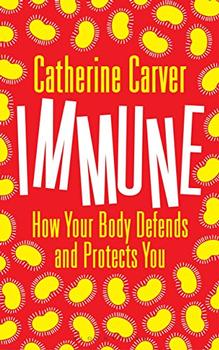Summary | Excerpt | Reviews | Beyond the Book | Readalikes | Genres & Themes | Author Bio

 Book Reviewed by:
Book Reviewed by:
Natalie Vaynberg
Buy This Book
One notable exception is Helicobacter pylori (aka H. pylori ), a bacterium that makes its home in the sticky mucus that lines the stomach. While the mucus gives H. pylori some protection from the gastric acid, it also employs a bit of clever chemistry to make its home a touch more comfortable. It secretes the enzyme urease, which converts a chemical called urea, naturally present in the stomach, to ammonia. The newly created ammonia is an alkaline, which neutralises the hydrochloric acid in the immediate vicinity of the H. pylori and creates a much more inhabitable pH. Historically it was believed that the stomach itself made 'gastric urease' but since the realisation that H. pylori was the true chemist, the 'urea breath test' has become a common way of spotting H. pylori . Patients swig a drink that contains urea made from a harmless type of carbon called C13. If H. pylori is present in the stomach, when it breaks down the C13 containing urea it will release carbon dioxide with an increased level of C13 which can be measured in a breath test.
About 40 per cent of us have H. pylori in our stomachs and for most people it causes no problems. However in about 15 per cent of these people the presence of the bacteria leads to inflammation and ulceration in the stomach. The discovery of this fact is the stuff of legend. Barry Marshall and Robin Warren had been trying for years to convince the medical community that H. pylori was capable of causing ulcers, but their idea ran counter to the established wisdom that stress and lifestyle factors were the main culprits. In a bid to provide incontrovertible evidence, Marshall underwent a gastric biopsy to prove that he had no H. pylori infection and no inflammation of his stomach. He then deliberately swigged some H. pylori and had another biopsy two weeks later, which showed that his stomach lining was now inflamed and H. pylori ensconced. Combined with all of their previous research, this remarkable feat persuaded the community that Marshall and Warren's radical theory was a genuine breakthrough. This blew the field of ulcer research wide open, leading to over 25,000 research articles, one dedicated journal ( Helicobacter ), a new treatment for stomach ulcers and a Nobel prize for Marshall and Warren.
Tears to fear
Our next defence divides the sexes. The average woman does it 47 times a year, the average man a measly 7 times, and 88 per cent of us feel better afterwards: crying. Yet the tears we shed aren't just cathartic, they're also a form of chemical warfare. Tears contain a mix of electrolytes such as sodium, potassium and chloride, as well as an estimated 80 – 100 proteins. From this mass of proteins there are three which are found in large quantities (lysozyme, lactoferrin and lipocalin), which help to protect our eyes from the various pathogens we inevitably poke into them with grubby fingers or past-its-best mascara.
So, to the stars of the show. Lysozyme is a minor celebrity in the antibacterial world, known for having been discovered by the legendary Alexander Fleming, king of the accidental scientific find. The year was 1921 and Fleming was on a quest for antibiotics. He had been dropping anything and everything into plates of growing bacteria strewn around his laboratory, hoping to find something to stop them in their tracks. One day he had a cold, and decided to add some of his own mucus to the bacteria. To his great surprise the mucus stopped the bacteria in their tracks, and the reason was lysozyme. This formidable enzyme is found in tears, snot, saliva and cervical mucus. It digests the protective chains of carbohydrate that are key to the make-up of bacterial cell walls. Without its protective wall the bacterium is no longer structurally sound and it bursts at the seams. Alas, lysozyme is too big a molecule to move between cells, preventing it from being an effective way of treating infections, which tend to spread throughout the body. Thus Fleming's quest for a medical antibiotic continued for five years until he came upon his Nobel prizewinning discovery of penicillin.
Excerpted from Immune by Catherine Carver. Copyright © 2017 by Catherine Carver. Excerpted by permission of Bloomsbury USA. All rights reserved. No part of this excerpt may be reproduced or reprinted without permission in writing from the publisher.





The House on Biscayne Bay
by Chanel Cleeton
As death stalks a gothic mansion in Miami, the lives of two women intertwine as the past and present collide.

The Flower Sisters
by Michelle Collins Anderson
From the new Fannie Flagg of the Ozarks, a richly-woven story of family, forgiveness, and reinvention.

The Funeral Cryer by Wenyan Lu
Debut novelist Wenyan Lu brings us this witty yet profound story about one woman's midlife reawakening in contemporary rural China.
Your guide toexceptional books
BookBrowse seeks out and recommends the best in contemporary fiction and nonfiction—books that not only engage and entertain but also deepen our understanding of ourselves and the world around us.